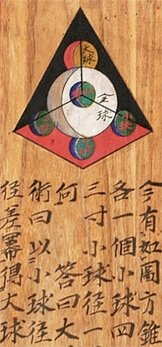The Sudoku of the 17th century
 Sangaku emerged during the 100-year period in which Japan cut itself off from West, allowing only one Dutch ship a year to dock. The cultural isolation did some odd things to the country's mathematicians. Since they didn't have access to the advances in math that Gottfried Wilhelm Leibniz and Isaac Newton had made in Europe, they developed unusual ways of solving classic calculus problems. They drew their enormous, sprawling solutions out on beautifully illustrated wooden tables, which they regarded as religious offerings.
Sangaku emerged during the 100-year period in which Japan cut itself off from West, allowing only one Dutch ship a year to dock. The cultural isolation did some odd things to the country's mathematicians. Since they didn't have access to the advances in math that Gottfried Wilhelm Leibniz and Isaac Newton had made in Europe, they developed unusual ways of solving classic calculus problems. They drew their enormous, sprawling solutions out on beautifully illustrated wooden tables, which they regarded as religious offerings.Sangaku fell into disrepute during the 20th century, but Tony Rothman, a Princeton Nobel nominee, is helping spearhead a movement to restore what he calls the sudoku of the 17th century. According to Rothman, “Sangaku tablets are perhaps unique among the world's cultural creations, as they are simultaneously objects of art, religious offerings and a record of what we might call folk mathematics.”

0 Comments:
Post a Comment
Subscribe to Post Comments [Atom]
<< Home